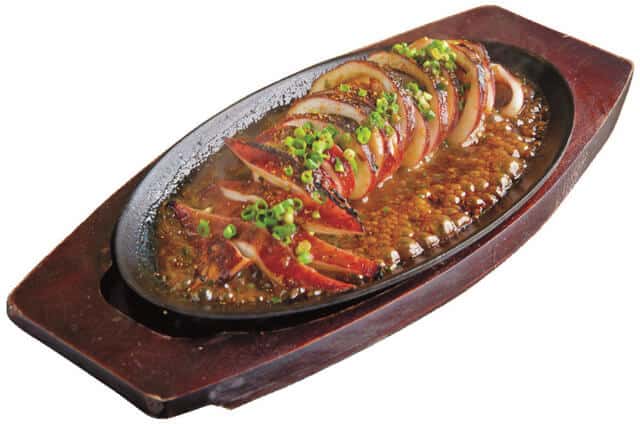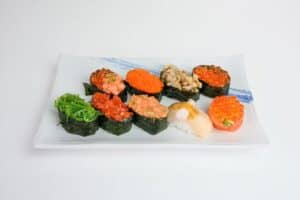Ikasomen is a refreshing and light dish, making it a popular choice for a summer meal in Japan. Combining the cold somen noodles and the tender squid is a delightful and cooling option during hot weather. Now, let’s get to know more about Ikasomen.
What is Ikasomen?

Ikasomen, a shredded raw squid, is a popular Japanese dish in Hokkaido with squid (ika) and somen noodles. Somen noodles are very thin wheat noodles that are typically served cold, especially during the hot summer. It gets its name because they can slurp it and eat it like somen noodles. They usually eat it by dipping it in soy sauce or mentsuyu. Squid that is hard to eat as sashimi has the advantage of being made softer by cutting it into thin pieces.
In the case of Ikasomen, the dish typically consists of thinly sliced or julienned squid, which is often blanched briefly to cook and then chilled. They placed the squid on a bed of cold somen noodles. It can be garnished with ingredients like shredded nori (seaweed), thinly sliced green onions, and grated ginger.
Ikasomen History

Ika somen has its roots in Hakodate, Hokkaido, where it was first created by slicing the locally caught squid into thin strips, resulting in a distinctively firm texture even when cut as thin as somen noodles. Although it might be less chewy, letting it age for a day can enhance its sweetness, which is a tasty option. The term “squid somen” is relatively new, and according to Junichi Watanabe, a Hokkaido native, it became popular “recently.” When you break down the name, it means finely chopped squid sashimi. However, it’s important to note that the exact duration of this name’s use in Hakodate, the place of its origin, needs further investigation. Going back a quarter of a century, Kenkichi Kusumoto described a dish similar to squid somen as “sea somen,” consisting of a bowl of raw squid cut into chunks, topped with grated earth ginger and soy sauce.
Hakodate, the city of squid

Hakodate is a city and port in Oshima Subprefecture, Hokkaido, Japan. Situated on the Tsugaru Strait between Hokkaido and Honshu. Squid somen is a specialty of Hakodate, famous for its squid in Hokkaido. The Japanese common squid spends its short life of one year migrating around the coast of Japan. Born in the East China Sea from autumn to winter, Japanese common squid travels north through the Sea of Japan on the Tsushima Current and Kuroshio Current, where they grow by eating plankton and sardines. Squid’s delicious taste comes from amino acids abundantly contained in its muscles. By the time the Japanese common squid migrate north to Hakodate, they have developed enough muscles and come in groups, making Hakodate the perfect place to catch squid when it is at its most delicious.
Fisheries cooperatives and wholesale markets in Hakodate are investing in the infrastructure to ensure the freshness of squid. They hold morning auctions for squid right after it’s caught and swiftly delivered to local stores and restaurants. This means you can savor the freshest squid in Hakodate. From June to December, you can enjoy common squid, while from January to May, you can relish surume squid, known for its thick, chunky flesh that can be prepared in various ways like sashimi or grilling. Spear squid, smaller and with finer meat than common squid, offers an elegant sweetness when enjoyed as sashimi.
How to enjoy Ikasomen?

To enjoy ikasomen, use wasabi soy sauce, mentsuyu, or ginger soy sauce to savor the sweet and tender squid. These days, you can find finely chopped squid sashimi in supermarkets, making it easy to prepare squid somen at home. Squid is a great frozen option, as it retains its freshness and taste even after extended freezing, so you can still enjoy it after thawing. If you end up with extra squid somen, you can freeze it properly and enjoy it as sashimi later.
Squid Health Benefits

Squid is a nutritious seafood choice with numerous health benefits. It is low in fat, high in quality protein, and low in calories, making it suitable for weight-conscious individuals. Squid’s chewy texture can help curb appetite by stimulating the satiety center, making it a valuable addition to a diet. Additionally, squid is a good source of lysine. This essential amino acid supports the production of antibodies, hormones, and enzymes in the body. It also contains taurine, which plays a role in maintaining normal bodily functions, improving deteriorated parts, lowering blood cholesterol and triglyceride levels, enhancing liver function, and aiding in preventing lifestyle-related diseases such as diabetes, hypertension, and arteriosclerosis.
Ikasomen FAQ
- What is the reason for the excellent freshness of squid?
-
The reason why Hakodate’s squid is so fresh is because of the cages set up on fishing boats. Freshly caught squid is packed onboard in styrofoam or wooden boxes filled with ice, and those that are kept in cages and transported to fishing ports are distributed as live squid, resulting in clear flesh and a crunchy texture.
- Why squid sashimi is thin?
-
Not only squid somen noodles but also regular squid sashimi are often cut vertically into thin pieces. Cutting the squid’s muscle fibers makes it softer and more accessible to eat. Squid’s muscle fibers are arranged horizontally to the body, so cut the muscle fibers by cutting the squid lengthwise.
Ikasomen Recipe

Ikasomen Ingredients
| Ingredients of Ikasomen for 2 persons | Measurements |
|---|---|
| Surumeika (body part) | 50g |
| Ginger | 5g |
| (A) Bonito soup stock | 20g |
| (A) Water | 28g |
| (A) Soy sauce | 14g |
| (A) Mirin | 7g |
How to make Ikasomen?
Remove the legs and membranes from the squid. Remove any remaining cotton or cartilage from the body and wash it thoroughly.
Put the bonito stock, water, soy sauce, and mirin in a pot, boil, and let cool.
Wipe off the moisture from the squid with kitchen paper, cut it in half lengthwise, then cut it lengthwise into thin strips, and serve on a plate lined with shiso leaves, garnished with grated ginger. Then, add the soup.
Where to buy Ikasomen?
Chamu Seafood Restaurant (朝市の味処 茶夢)

A restaurant located in Donburi Yokocho Market in Hakodate Morning Market. The sweetness of squid is essential, and all squid used is morning squid. Each set meal comes with 5 to 6 small plates, such as boiled squid and salted fish. This restaurant’s style is to pour soy sauce directly onto the squid and stir it with the ginger seasoning.
Gyosanko (大衆居酒屋魚さんこ)

There are 25 to 30 types of fresh seafood sashimi that the owner goes to the market every day to purchase. The most popular live squid is the live squid, and it’s fun to see the live squid before the staff cuts it. Not only the meat and innards but also the eyes and mouth are cut to make it easier to eat. Price varies depending on the size of the squid.
Kaikobo (函館海鮮料理 海光房)

A seafood izakaya located in Hakodate Asaichi that a seafood company directly manages. There is a sizeable 9-ton aquarium in the store, filled with fresh seafood. You can also choose your favorite seafood and cook it on the spot. Another appeal is that you can enjoy the same menu during the day as at night.
Final Thoughts

In Japan, Ikasomen is a delightful dish that beautifully blends the flavors and textures of squid and somen noodles. Its refreshing and light qualities make it a perfect choice, especially during the hot summer. Whether you’re a fan of seafood or simply looking for a unique culinary experience, take advantage of the opportunity to savor Ikasomen when you visit Japan. The combination of tender squid and chilled somen noodles, along with the various dipping sauces and garnishes, creates a memorable and delicious dish that captures the essence of Japanese cuisine. So, the next time you find yourself in Japan, try Ikasomen and savor the taste of this delectable seafood delight.
You can check some Japanese seafood dishes that we know you would like to try too.
















Comments